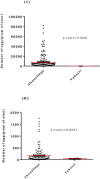Serious limitations of the current strategy to control Soil-Transmitted Helminths and added value of Ivermectin/Albendazole mass administration: A population-based observational study in Cameroon
- PMID: 33141853
- PMCID: PMC7665818
- DOI: 10.1371/journal.pntd.0008794
Serious limitations of the current strategy to control Soil-Transmitted Helminths and added value of Ivermectin/Albendazole mass administration: A population-based observational study in Cameroon
Abstract
Background: Soil-transmitted helminth (STH) infections remain a public health concern in sub-Saharan Africa. School-based mass drug administration (MDA) using the anthelminthic drug Mebendazole/Albendazole have succeeded in controlling morbidity associated to these diseases but failed to interrupt their transmission. In areas were filarial diseases are co-endemic, another anthelminthic drug (Ivermectin) is distributed to almost the entire population, following the community-directed treatment with ivermectin (CDTI) strategy. Since Ivermectin is a broad spectrum anthelmintic known to be effective against STH, we conducted cross-sectional surveys in two health districts with very contrasting histories of Ivermectin/Albendazole-based PC in order to investigate whether CDTI might have contributed in STH transmission interruption.
Methodology: Cross-sectional surveys were conducted in two health districts with similar socio-environmental patterns but with very contrasting CDTI histories (Akonolinga health district where CDTI was yet to be implemented vs. Yabassi health district where CDTI has been ongoing for two decades). Stool samples were collected from all volunteers aged >2 years old and analyzed using the Kato-Katz technique. Infections by different STH species were compared between Akonolinga and Yabassi health districts to decipher the impact of Ivermectin/Albendazole-based MDA on STH transmission.
Principal findings: A total of 610 and 584 participants aged 2-90 years old were enrolled in Akonolinga and Yabassi health districts, respectively. Two STH species (Ascaris lumbricoides and Trichuris trichiura) were found, with prevalence significantly higher in Akonolinga health district (43.3%; 95% CI: 38.1-46.6) compared to Yabassi health district (2.5%; 95% CI: 1.1-5.1) (chi-square: 90.8; df: 1; p < 0.001).
Conclusion/significance: These findings (i) suggest that Mebendazole- or Albendazole-based MDA alone distributed only to at-risk populations might not be enough to eliminate STH, (ii) support the collateral impact of Ivermectin/Albendazole MDA on A. lumbricoides and T. trichiura infections, and (iii) suggest that Ivermectin/Albendazole-based PC could accelerate STH transmission interruption.
Conflict of interest statement
The authors have declared that no competing interests exist.
Figures



Similar articles
-
Persistent transmission of soil-transmitted helminths despite 16 years of uninterrupted Mebendazole- and ivermectin-based preventive chemotherapy in the Lomie Health District (East Region, Cameroon): The emergency of complementary control strategies.PLoS Negl Trop Dis. 2024 Sep 25;18(9):e0012508. doi: 10.1371/journal.pntd.0012508. eCollection 2024 Sep. PLoS Negl Trop Dis. 2024. PMID: 39321251 Free PMC article.
-
The impact of four years of semiannual treatments with albendazole alone on lymphatic filariasis and soil-transmitted helminth infections: A community-based study in the Democratic Republic of the Congo.PLoS Negl Trop Dis. 2020 Jun 23;14(6):e0008322. doi: 10.1371/journal.pntd.0008322. eCollection 2020 Jun. PLoS Negl Trop Dis. 2020. PMID: 32574160 Free PMC article.
-
Soil-transmitted helminth infection in school age children in Sierra Leone after a decade of preventive chemotherapy interventions.Infect Dis Poverty. 2019 Jul 2;8(1):41. doi: 10.1186/s40249-019-0553-5. Infect Dis Poverty. 2019. PMID: 31262367 Free PMC article.
-
Efficacy of current drugs against soil-transmitted helminth infections: systematic review and meta-analysis.JAMA. 2008 Apr 23;299(16):1937-48. doi: 10.1001/jama.299.16.1937. JAMA. 2008. PMID: 18430913
-
Efficacy of albendazole against soil-transmitted helminth infections in Ethiopia: a systematic review and meta-analysis.Sci Rep. 2024 Sep 20;14(1):21970. doi: 10.1038/s41598-024-71308-3. Sci Rep. 2024. PMID: 39304661 Free PMC article.
Cited by
-
Persistent transmission of soil-transmitted helminths despite 16 years of uninterrupted Mebendazole- and ivermectin-based preventive chemotherapy in the Lomie Health District (East Region, Cameroon): The emergency of complementary control strategies.PLoS Negl Trop Dis. 2024 Sep 25;18(9):e0012508. doi: 10.1371/journal.pntd.0012508. eCollection 2024 Sep. PLoS Negl Trop Dis. 2024. PMID: 39321251 Free PMC article.
-
High infection rates for onchocerciasis and soil-transmitted helminthiasis in children under five not receiving preventive chemotherapy: a bottleneck to elimination.Infect Dis Poverty. 2022 Apr 28;11(1):47. doi: 10.1186/s40249-022-00973-1. Infect Dis Poverty. 2022. PMID: 35484570 Free PMC article.
-
Successful Management of Biliary Ascariasis in a High-Endemic Zone and Low-Resource Setting in Ethiopia.Case Rep Infect Dis. 2022 Dec 2;2022:8201398. doi: 10.1155/2022/8201398. eCollection 2022. Case Rep Infect Dis. 2022. PMID: 36504673 Free PMC article.
-
Impact of ivermectin mass drug administration on burden of soil-transmitted helminths in onchocerciasis control and elimination programs, Yeki district, southwest Ethiopia.PLoS One. 2022 Feb 10;17(2):e0263625. doi: 10.1371/journal.pone.0263625. eCollection 2022. PLoS One. 2022. PMID: 35143567 Free PMC article.
-
Fine mapping of Ascaris lumbricoides, Trichuris trichiura and hookworm infections in sub-districts of Makenene in Centre Region of Cameroun.Sci Rep. 2022 Aug 17;12(1):13935. doi: 10.1038/s41598-022-18285-7. Sci Rep. 2022. PMID: 35978014 Free PMC article.
References
-
- Bethony J, Brooker S, Albonico M, Geiger S, Loukas A, Diemert D, et al. Soil-transmitted helminth infections: ascariasis, trichuriasis, and hookworm. The Lancet. 2006;367:1521–32. - PubMed
-
- World Health Organization. Soil-transmitted helminth infections [Internet]. World Health Organ. 2019. Available from: https://www.who.int/news-room/fact-sheets/detail/soil-transmitted-helmin....
-
- Cano J, Rebollo MP, Golding N, Pullan RL, Crellen T, Soler A, et al. The global distribution and transmission limits of lymphatic filariasis: past and present. Parasit Vectors [Internet]. 2014;7:466–466. Available from: https://www.ncbi.nlm.nih.gov/pubmed/25303991. 10.1186/s13071-014-0466-x - DOI - PMC - PubMed
-
- World Health Organization. Guideline: preventive chemotherapy to control soil-transmitted helminth infections in at-risk population groups. World Health Organization; 2017. - PubMed
Publication types
MeSH terms
Substances
LinkOut - more resources
Full Text Sources
Miscellaneous

